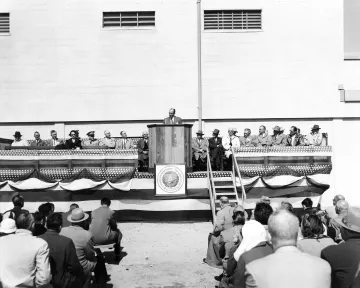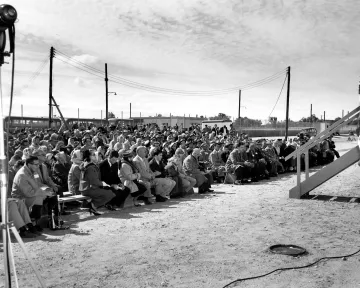Guest post from Tod Companion, PhD, director of the Science and Technology Directorate’s Plum Island Animal Disease Center (PIADC).

This month, PIADC marks 7 decades of protecting U.S. agriculture and livestock from transboundary animal diseases. These diseases are highly contagious and capable of rapid spread with the potential to produce high morbidity/mortality rates. While PIADC scientists do not research diseases that pose health threats to humans, these diseases do pose significant threats to food and agriculture security, trade, and the economy.
To combat these threats, the U.S. Department of Agriculture (USDA) established the laboratory on Plum Island in 1954 following the passage of Public Law 80-496 by Congress. This enabled the Secretary of Agriculture to research foot-and-mouth disease (FMD) and other animal diseases on an island separate from the mainland—an early nod to biosecurity measures. Formerly home to the U.S. Army’s Ft. Terry, structures on Plum Island were refitted and repurposed to meet USDA’s research needs until construction of a new lab was completed and inaugurated in 1956.

Post 9/11, in 2003 the USDA conferred management and oversight of the lab to the newly formed U.S. Department of Homeland Security (DHS). Since then, PIADC has operated as a partnership between DHS, USDA Agricultural Research Service (ARS), and USDA Animal and Plant Health Inspection Service (APHIS). To ensure the nation is prepared to respond to, control, and recover from an outbreak on the U.S. mainland, PIADC scientists from DHS, ARS, and APHIS focus their research on detection technologies, diagnostics, therapeutics, and decontamination technologies.
The research conducted by PIADC scientists over these 70 years has been transparent and accessible to the public and the scientific community through the publication of hundreds of articles in peer-reviewed scientific journals. This research has directly contributed to scientific breakthroughs, including the characterization, and contributions to the elimination of the cattle plague Rinderpest—one of only two diseases (the other being Smallpox) eradicated by humankind—and the development of two functional FMD vaccines, which have helped ensure the U.S. mainland has been free of FMD for nearly 100 years.

More recently, USDA scientists at PIADC collaborated with colleagues in Vietnam to develop the first two commercially available vaccines to protect against African swine fever (ASF). DHS scientists continue to investigate the stability of ASF and FMD in and on various matrices and surfaces under different environmental conditions to allow farmers and producers to protect livestock and prevent outbreaks and to provide policy makers and state and local animal health officials with information that can aid in response and recovery planning.
Another vital function of the lab has been training foreign animal disease diagnosticians (FADD). Since 1971, the USDA APHIS FADD course has allowed federal and state veterinarians to observe transboundary animal diseases of economic importance, including FMD and ASF, in a controlled environment. Over more than 50 years, USDA APHIS has hosted hundreds of courses, training thousands of veterinarians to identify these diseases in the field, thereby protecting our animals and our food supply.
As PIADC marks its 70th year, we find ourselves looking forward to the transition of the scientific mission to the National Bio and Agro-Defense Facility and the eventual closure of the lab. Until that transition occurs, it continues to be my honor to serve as PIADC Director, supporting its essential mission, and leading a diverse workforce of scientific, animal care, administrative, operations and maintenance, and transportation personnel, all of whom contributed through the years to the fulfillment of our mission and the establishment our legacy. To preserve this legacy, we are working with the National Archives and Records Administration to prepare permanent historic and scientific records and artifacts for accession to ensure the island’s history and our important scientific body of work is available for future generations.
Learn more about the storied history of the lab on our PIADC 70th anniversary site.
